NCERT Solution (Part - 2) - Issue and Redemption of Debentures | Accountancy Class 12 - Commerce PDF Download
Page No 143:
Long Answers
Question 1: Explain the different types of debentures?
ANSWER: Debentures are issued by a company for acquiring long-term borrowings.
They can be classified on the following basis.
1. On the basis of Security
a. Secured Debentures- Mortgaged Debentures are those debentures that are secured against asset/s of a company. These are also known as secured debentures. In case the company fails to pay back the principal amount of debenture or fails to meet its interest obligations on the due date, then the debenture holders have the right to sell the mortgaged asset in order to realise their amount due to the company.
b. Unsecured Debentures- These debentures are treated as unsecured creditors. They do not have any security. These are uncommon now days.
2. On the basis of Tenure
a. Redeemable Debenture- These debentures are payable after the expiry of a specific period. These debentures can be redeemed at par or premium either in lump sum or in installment. Generally all debentures are redeemable.
b. Irredeemable Debenture- Irredeemable Debentures are those debentures that cannot be repayable or redeemable by a company during its life time. These are repayable only at the time of winding up of the company. These are also known as Perpetual Debentures that means debentures having indefinite life. In India, now days, no company can issue irredeemable debentures.
3. On the basis of Mode of Redemption
a. Convertible Debentures- Convertible Debentures are those debentures that can be converted into equity shares after a specified period of time. These are of following two types:
i. Fully Convertible Debentures: When the whole amount of a debenture is convertible into equity shares of equivalent amount, then these debentures are called Fully Convertible Debentures. There is no need to maintain Debenture Redemption Reserves for such debentures.
ii. Partly Convertible Debentures: When only a part of the amount of a debenture is convertible into equity shares, then these debentures are called Partly Convertible Debentures. In this regards, the Debenture Redemption Reserve is maintained only for the non-convertible part of the debenture.
b. Non-Convertible Debenture- These debentures cannot be converted into shares. Generally debentures are non convertible.
4. On the basis of Coupon Rate
a. Zero Coupon Rate- These debentures do not contain a specific rate of interest and can be issued at discount. The excess of the face value of the debenture over its issue price is considered as interest amount.
b. Specific Rate- These debentures carry a specific rate of interest which may be fixed or floating.
5. On the basis of Registration
a. Registered Debenture- While issuing such debentures, the company maintains a record regarding name, address and number of holding of debentures in the Register of Debenture Holders of the company.
b. Bearer Debentures- When a company does not maintain any record of the debenture holders and the debenture is transferable mere by delivery, then the type of the debenture held by the holders is termed as Bearer Debenture. Interests on such debentures are paid to the persons who produce the interest coupons that are attached with these debentures in a specified bank.
Question 2: Distinguish between a debenture and a share. Why is debenture known as loan capital? Explain.
ANSWER:
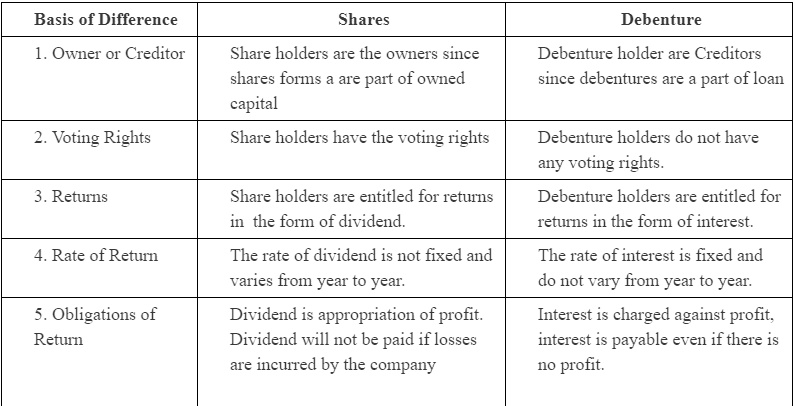
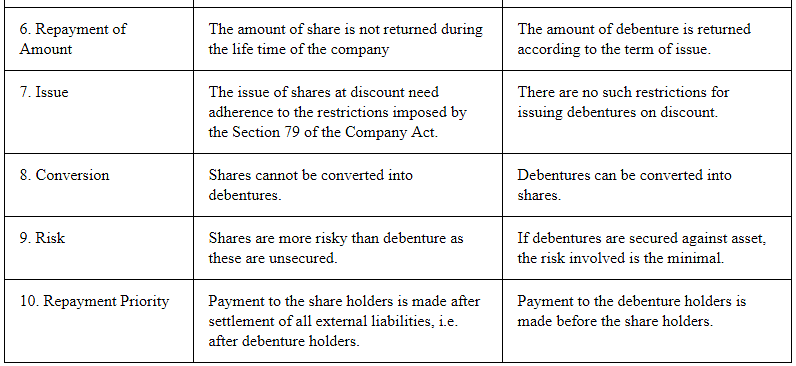
Issue of debentures implies incurring long-term indebtedness. Generally, a company issues debentures for acquiring long-term borrowings to achieve its long-run targets and growth. Like the owner’s capital, interest is also payable on the principal amount of the debenture. The interest paid is regarded as an expense for the company and is deductible under Income Tax Act. Therefore, debentures are also known as loan capital because they are redeemable after a long period of time.
Question 3: Describe the meaning of ‘Debenture Issued as Collateral Securities’. What accounting treatment is given to the issue of debentures in the books of accounts
ANSWER: The term collateral security means additional or secondary security in addition to the primary security. Sometimes, when a company takes loan from a financial institution, then besides the primary security, the company may issue debenture for additional security (as collateral security). The lender who receives debenture as collateral security is not entitled for interest on these debentures. If any default is made by the company in paying back the principal amount (i.e. the loan amount) or interest on the loan, then the lender has the full right to recover his/her dues from the sale of primary security. But, if the primary security is not sufficient to recover the amount of debt, then the debentures issued as collateral may be used for recovery of the remaining amount.
Accounting Treatment
There are two ways to record issue of debentures as collateral security:
1. No Entry
As no liability has been created so no Journal entry is recorded in the books of account. As per the Revised Schedule-VI of the Companies Act, the issue of debenture as collateral security is shown as a Long-Term Borrowings under the heading of Non-Current Liabilities on the Equity and Liabilities side of the Balance Sheet. In the Notes to Accounts of Long-Term Borrowings, the Loan so taken is shown. And in the Notes to Accounts of Cash and Cash Equivalents, the amount of loan so received (in cash) is shown. This can be better understood with the help of the below explained example.
Example- Suppose Best Bus Ltd. issued 4,000 9% Debentures of Rs 100 each as collateral security to NBP bank for a loan of Rs 3,00,000.
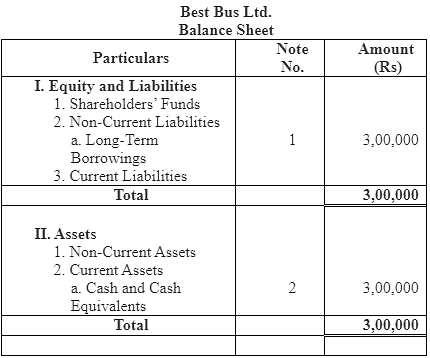

2. By Making Entry
In order to record the issue of debentures as collateral security, the following necessary Journal entries are made in the books of account.
At the time of Issue of Debentures as Collateral Security
In this case, as per the Revised Schedule VI of the Companies Act, Debentures so issued as collateral security will be shown as Long-Term Borrowings under the head of Non-Current Liabilities of the Equity and Liabilities side of the Company's Balance Sheet. Unlike Method-1, in this method, Debentures Suspense Account is deducted from the Debentures Account in the Notes to Accounts of Long-Term Borrowings.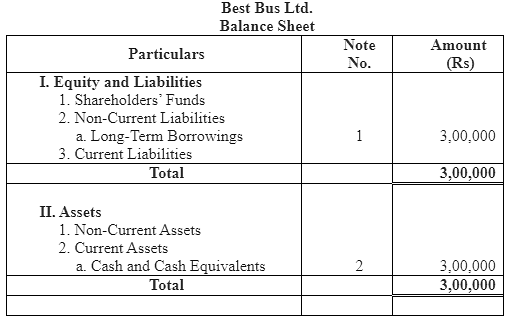
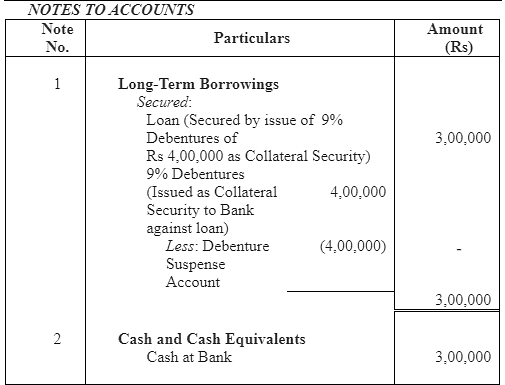
Question 4: How is ‘Discount on Issue of Debentures’ treated in the books of accounts? How will you deal with the ‘discount in issue of debentures’ when the debentures are to be redeemed in instalments?
ANSWER: When the debentures are issued at a price below its par value or face value, then it is said that the debentures are issued at discount. The difference between the issue price and the face value of the debenture is regarded as a capital loss. As per the Revised Schedule VI of the Companies Act, Discount on Issue of Debentures is shown in the Notes to Accounts:
1. With the amount that is to be written off within 12 months from the date of Balance Sheet - Shown under Other Current Assets
2. With the amount that is to be written off after 12 months from the date of Balance Sheet - Shown under Other Non-Current Assets
Accounting Treatment
For example, if a company has issued 10% debentures of Rs 6,00,000 at 5% discount redeemable annually by Rs 2,00,000 each year. The total amount of discount on Rs 6,00,000 debentures @ 5% is Rs 30,000, i.e. (6,00,000 × 5/100 = Rs 30,000). The accounting treatment for discount on issue of debentures(if it is to be written-off in 5 years) is:
Year 1: Amount to be written-off each year = Shown in Statement of Profit and Loss
Shown in Statement of Profit and Loss
Amount to be written-off in the next year = 6,000 - Shown as Other Current Asset under Current Assets
Remaining Amount to be written-off after next year = 30,000 − 6,000 − 6,000= 18,000 - Shown as Other Non-Current Asset under Non-Current Assets
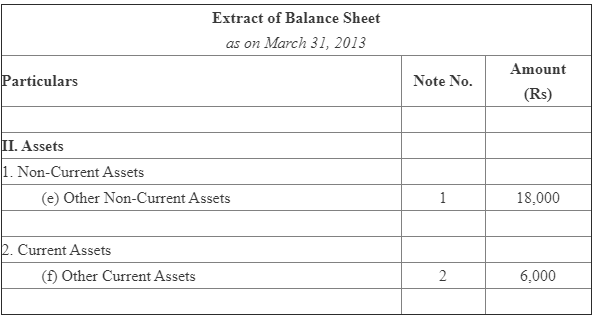
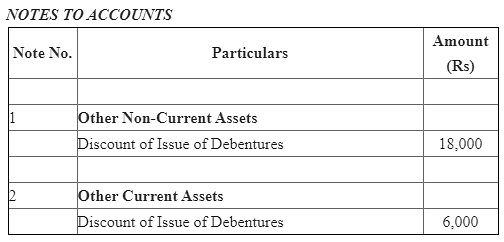
Year 2
Amount to be written-off =  Shown in Statement of Profit and Loss
Shown in Statement of Profit and Loss
Amount to be written-off in the next year = 6,000 - Shown as Other Current Asset under Current Assets
Remaining Amount to be written-off after next year = 18,000 − 6,000 = 12,00018,000 - 6,000 = 12,000 - Shown as Other Non-Current Asset under Non-Current Assets
At the end of Year 5, the amount of discount on issue of debentures will be completely written off.
Question 5: Explain the different terms for the issue of debentures with reference to their redemption.
ANSWER: The different terms for the issue of debentures with reference to their redemption can be the combinations of at par, at premium and at discount. Normally, the debentures are not redeemable at discount. The permutation and the combination of the various terms of issue and redemption of debentures give rise to following six situations:
1. Issue at Par, Redeemable at Par.
2. Issue at Premium, Redeemable at Par.
3. Issue at Discount, Redeemable at Par.
4. Issue at Par, Redeemable at Premium.
5. Issue at Premium, Redeemable at Premium.
6. Issue at Discount Redeemable at Premium.
1. Issue at Par and Redeemable at Par- When the debentures are issued and are redeemed at their face value, then the following Journal entry is passed.
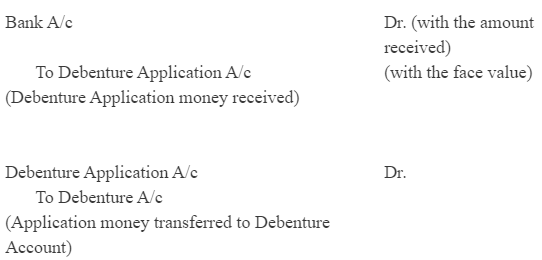
2. Issue at Premium and Redeemable at Par- When the debentures are issued at premium and are redeemable at par, then the following Journal entry is passed. As premium is a gain for a company so it is credited in the Journal entry.
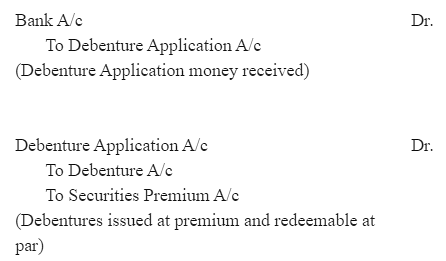
3. Issue at Discount and Redeemable at Par- When the debentures are issued at discount and are redeemable at par, then the following Journal entry is passed. As discount is a loss for a company so it is debited in the Journal entry.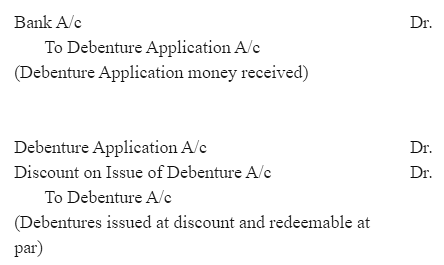
4. Issue at Par and Redeemable at Premium- When debentures are issued at par and redeemable at premium, then the following Journal entry is passed. In such case, the company did not suffer any loss at the time of issue but there will be loss at the time of redemption.

5. Issued at Premium and Redemption at Premium- When the debentures are issued and redeemable at premium, then the following Journal entry is passed.

6. Issue of Discount and Redemption at Premium- When the debentures are issued at discount and redeemable at premium, then the following Journal entry is passed.

Question 6: Differentiate between redemption of debentures out of capital and out of profits.
ANSWER: Redemption of Debentures Out of Capital
When debentures are redeemed out of capital and no profits are utilised for redemption, then such redemption is termed as redemption out of capital. In such a situation, no profits are transferred to the Debenture Redemption Reserve (DRR).
As per the guideline laid down by Securities and Exchange Board of India (SEBI) and the Section 117C of Company Act of 1956, the creation of DRR is mandatory (DRR). Therefore, it is not possible to redeem debentures purely out of capital, as it reduces the value of assets. The following companies are exempted from the creation of DRR.
1. Infrastructure companies (i.e. those companies that are engaged in the business of developing, maintaining and operating infrastructure facilities)
2. A Company that issues debentures with a maturity up to 18 months
Redemption of Debenture Out of Profits
When debentures are redeemed out of profit then no capital is utilised for redemption. Before redeeming the debentures profits are transferred to DRR from Profit and Loss Appropriation Account. The creation of DRR is mandatory as per the guidelines laid down by Securities and Exchange Board of India (SEBI). SEBI mandates transferring amount equal to 50% of debentures issued to DRR before redeeming debentures. In this method, as profits are transferred to the DRR Account, thereby reducing the total amount of profits, therefore this method is termed as Redemption of Debentures Out of Profits. In this method, first of all, the required profits are transferred from Statement of Profit and Loss to the DRR Account. The working of which is shown in the Notes to Accounts of Reserves and Surplus (as prescribed in Revised Schedule VI). The final balance (after considering DRR) is shown as the sub-head 'Reserves and Surplus' under the main head of Shareholders' Funds on the Equity and Liabilities side of the Company's Balance Sheet. Lastly, when all the debentures are redeemed, then DRR account is closed by transferring its amount to the General Reserve.
Question 7: Explain the guidelines of SEBI for creating Debenture Redemption Reserve.
ANSWER: The following are the main points of SEBI’s guidelines for creation of Debenture Redemption Reserve (DRR).
1. Every company that issues debentures with a maturity of more than 18 months shall create DRR.
2. An amount equal to 50% of debenture issued shall be transferred to DRR before starting redemption of debentures.
3. Creation of DRR is applicable only for Non-Convertible Debentures and for non-convertible part of Partly Convertible Debentures.
4. Any withdrawal from DRR is allowed only after 10% of debentures are redeemed.
Thus, as per the SEBI’s guidelines, 50% of the debentures issued should be redeemed out of the profits that are transferred to DRR and the remaining 50% of the debentures issued can be redeemed either out of profits or out of capital. Hence, no company can redeem all the debentures issued purely out of the capital.
As per the SEBI’s guidelines the following companies are exempted from the creation of DRR.
1. Infrastructure companies (i.e. those companies that are engaged in the business of developing, maintaining and operating infrastructure facilities)
2. A Company that issues debentures with a maturity up to 18 months
Question 8: Describe the steps for creating Sinking Fund for redemption of debentures.
Answer: The various steps involved in the creation of Sinking Fund for redemption of debentures can be better understood by the help of the example explained below.
A Company issued 10% Debentures of Rs 5,00,000 for 3 years. The investment is expected to earn 6% p.a. The Sinking Fund table shows that 0.31411 invested annually at 6% amount to Rs 1 in 3 years.
Step 1: Calculate the amount of instalment to be required every year for investment with the help of the Sinking Fund table. Like in the example Rs 1,57,055 (i.e. 0.31411 × 5,00,000) is required every year.
Step 2: The amount of instalment calculated in the above step is transferred to the Debenture Redemption Fund (Sinking Fund) by debiting from Profit and Loss Appropriation Account.
Step 3: In the first year, the above instalment is invested to yield amount required for redemption of debenture by debiting Debenture Redemption Fund Investment Account.
Step 4: The interest on investment is received on half yearly or annual basis. In the example, the interest of Rs 9,423 is received on annual basis.

Step 5: The total amount of investment, i.e. interest plus instalment is invested in the subsequent year. In the example, Rs 1,66,478 (i.e. Rs 1,57,055 + Rs 9,423) is invested in the next year.
Step 6: Repeat the Step 2, 3, 4 for each subsequent years up to the end of the life of the debenture. In the year of redemption, the instalment (i.e. the last instalment) will be debited to the Profit and Loss Appropriation Account but will not be invested.
Step 7: In the year of redemption, the investment is sold off.
Step 8: The profit (loss) on the sale of the investment is transferred by debiting (crediting) Debenture Redemption Fund Investment Account to the Debenture Redemption Fund Account.
Step 9: The payment to the debenture holder is made.
Step 10: The balance of Debenture Redemption Fund Account if any, is transferred to the General Reserve.
Question 9: Can a company purchase its own debentures in the open market? Explain.
ANSWER: Yes, a company can purchase its own debentures provided it is authorised by its Article of Association. As per the Company Act, if a company is authorised by its Article of Association, only then it may purchase its own debentures from the open market. The main purposes of such purchase are as follows:
1. For immediate cancellation of debenture liability, if the interest rate on its debenture is higher than the market rate of interest.
2. A company may also purchase its own debentures with the motive of investment and sell them at higher price in future and thereby earn profit.
A company may purchase its own debentures at discount or at premium for cancellation.
1. If Debentures are purchased at Discount for Cancellation
When the company purchases its own debentures at discount for cancellation, then the following Journal entries are recorded.


2. If Debentures are Purchased at Premium for Cancellation

Question 10: What is meant by conversion of debentures? Describe the method of such a conversion.
ANSWER: When a debenture holder can convert his/her debentures into shares or new debentures after the expiry of a specified period of time, then it is known as redemption of debentures by conversion. As the company does not need to pay any funds for the redemption, so there is no need to maintain Debenture Redemption Reserve (DRR). The new shares or debentures may be issued at par, premium or at discount.
If a debenture holder exercises the conversion option, then the issue price of shares must be equal to or less than the amount actually received from debentures.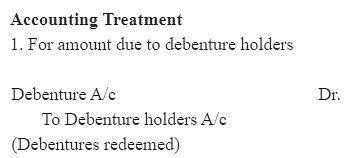
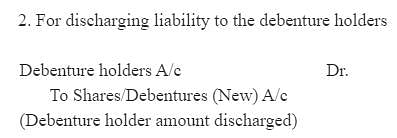
Page No 143:
Numerical Questions:
Question 1: G.Ltd. issued 75,00,000, 6% Debenture of Rs 50 each at par payable Rs 15 on application and Rs 35 on allotment, redeemable at par after 7 years from the date of issue of debenture. Record necessary entries in the books of Company.
Answer: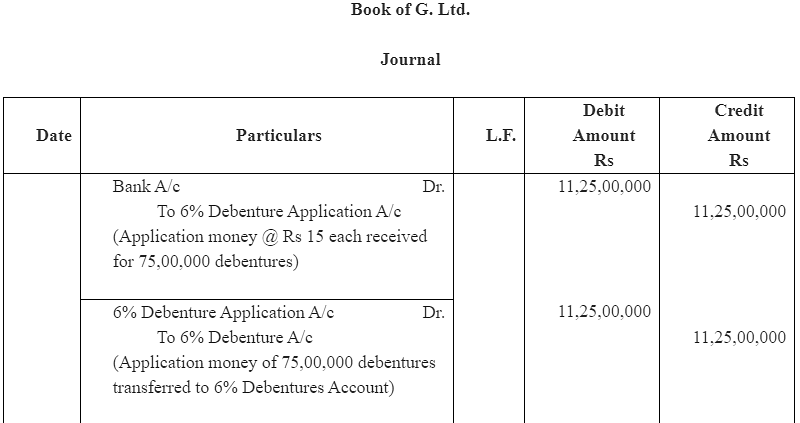

Question 2: Y.Ltd. issued 2,000, 6% Debentures of Rs 100 each payable as follows: Rs 25 on application; Rs 50 on allotment and Rs 25 on First and Final call.
ANSWER: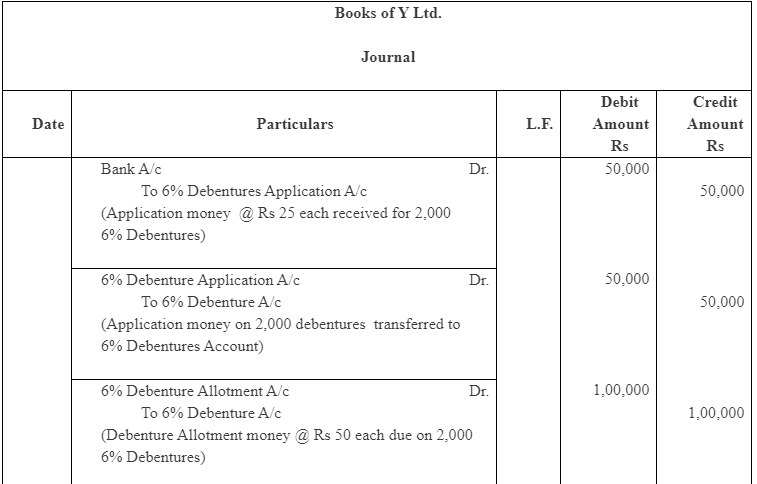
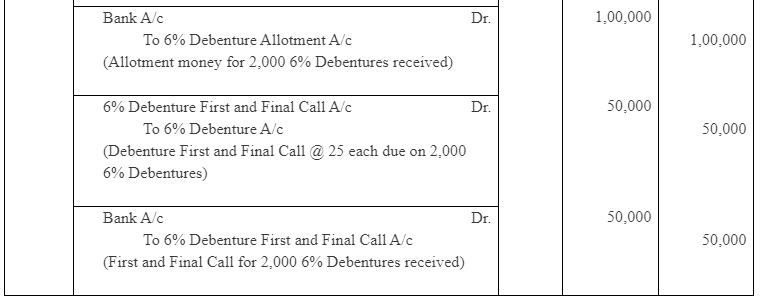
Question 3: A.Ltd. issued 10,000, 10% Debentures of Rs 100 each at a premium of 5% payable as follows:
Rs 10 on Application;
Rs 20 along with premium on allotment and balance on First and Final call. Record necessary Journal Entries.
ANSWER: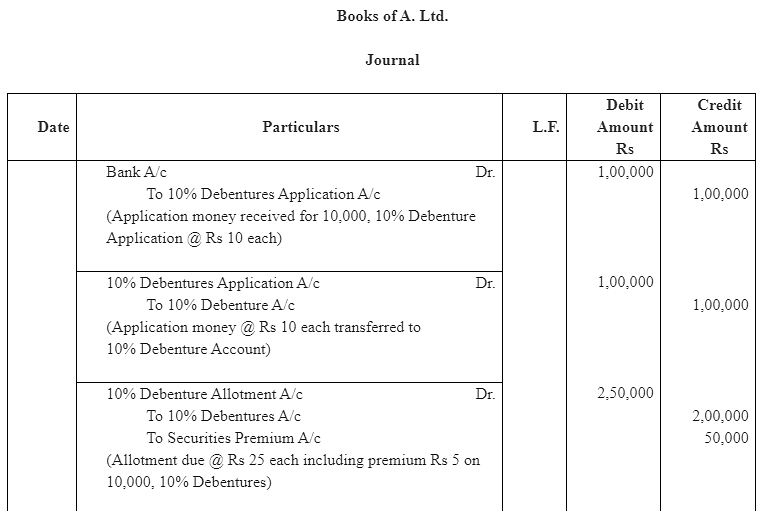
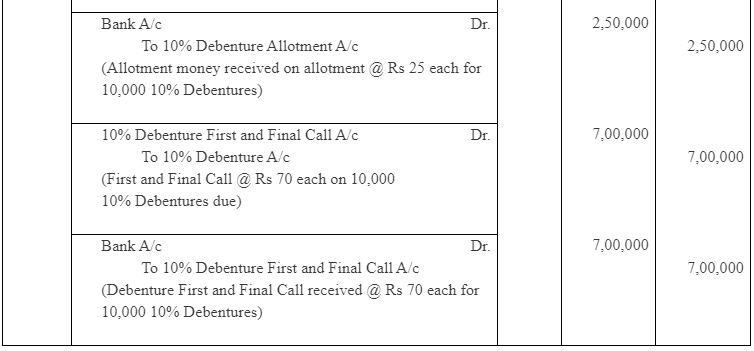
Page No 144:
Question 4: A. Ltd. issued 90,00,000, 9% Debenture of Rs 50 each at a discount of 8%, redeemable at par any time after 9 years. Record necessary entries in the books of A. Ltd.
ANSWER:
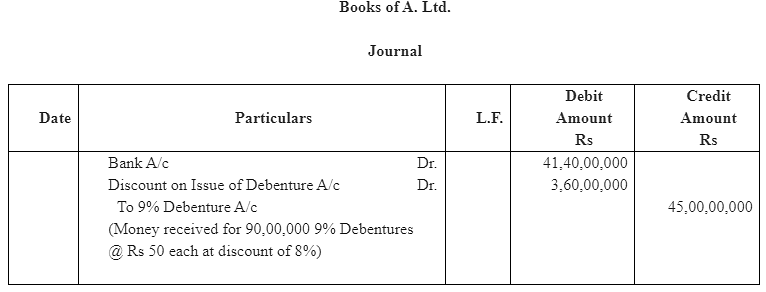
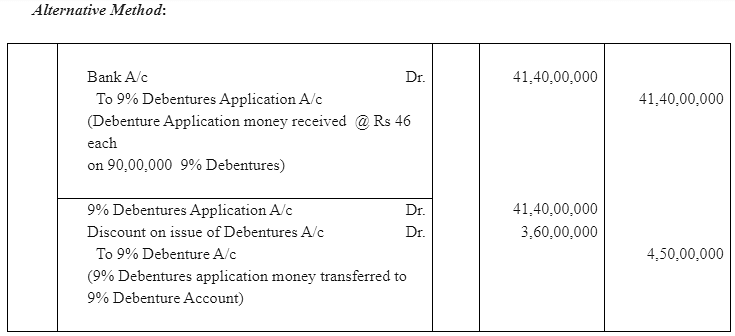
Question 5: A. Ltd. issued 4,000, 9% Debentures of Rs 100 each on the following terms:
Rs 20 on Application;
Rs 20 on Allotment;
Rs 30 on First call; and
Rs 30 on Final call.
The public applied for 4,800 Debentures. Applications for 3,600 Debentures were accepted in full. Applications for 800 Debentures were allotted 400 Debentures and applications for 400 Debentures were rejected.
ANSWER: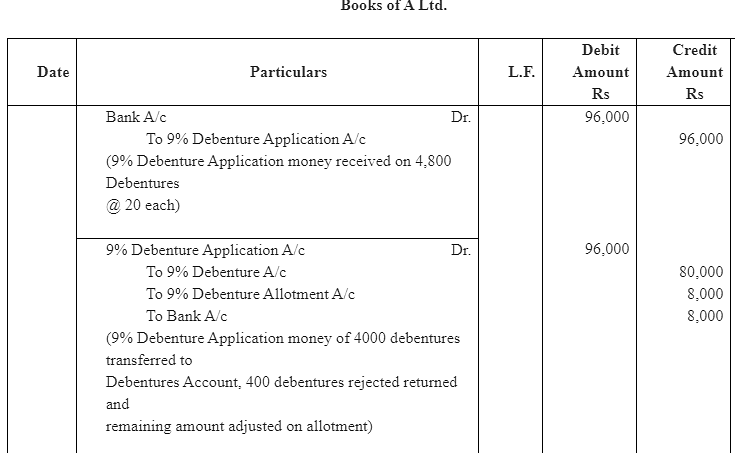
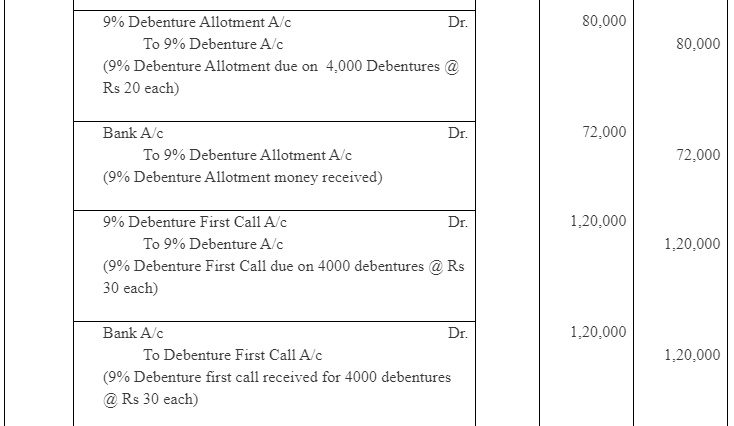

Question 6: T. Ltd. offered 2,00,000, 8% Debenture of Rs 500 each on June 30, 2002 at a premium of 10% payable as Rs 200 on application (including premium) and balance on allotment, redeemable at par after 8 years. But application are received for 3,00,000 debenture and the allotment is made on pro-rata basis. All the money due on application and allotment is received. Record necessary entries regarding issue of debenture.
ANSWER: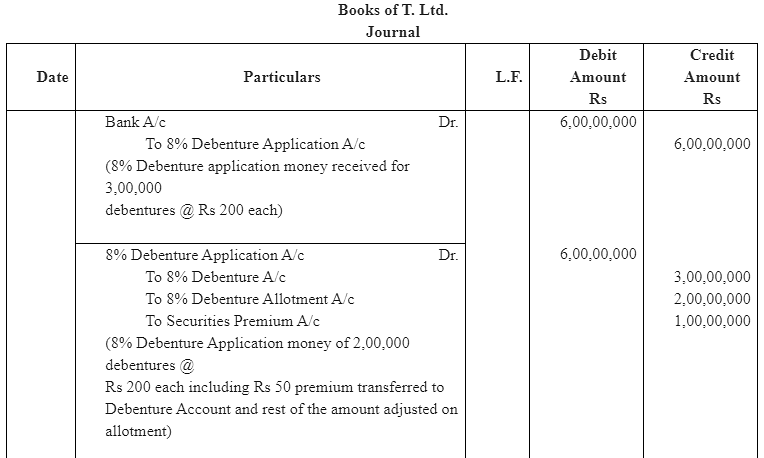

Question 7: X.Ltd. invites application for the issue of 10,000, 14% debentures of Rs 100 each payable as to Rs 20 on application, Rs 60 on allotment and the balance on call. The company receives applications for 13,500 debentures, out of which applications for 8,000 debentures are allotted in full, 5,000 only 40% and the remaining rejected. The surplus money on partially allotted applications is utilised towards allotment. All the sums due are duly received.
ANSWER: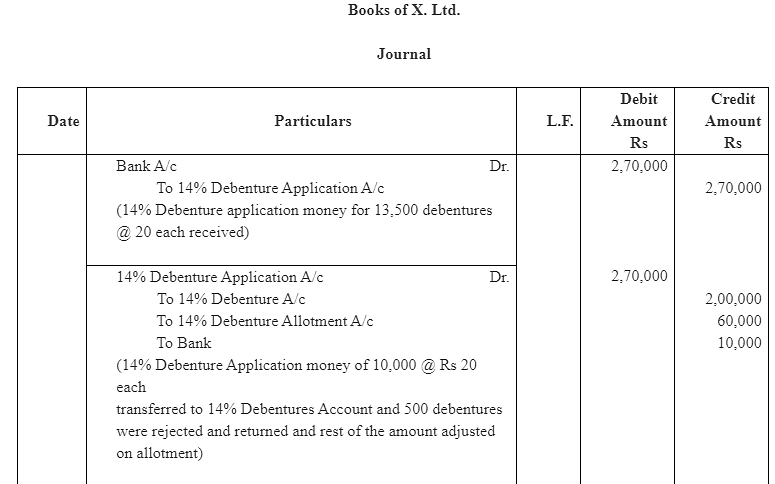
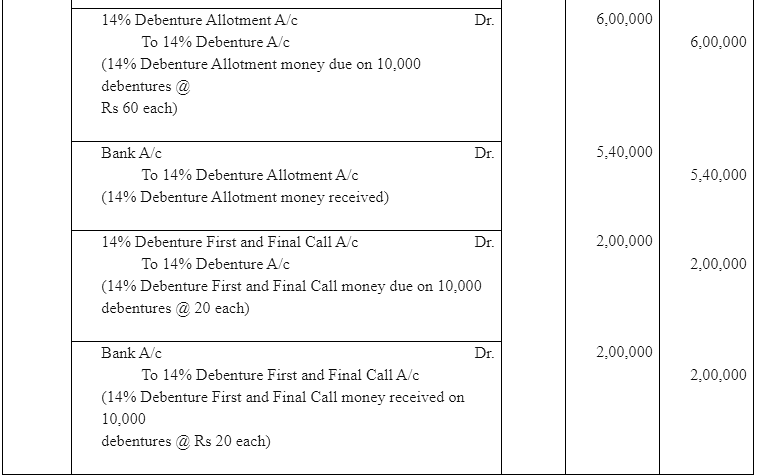
Question 8: R.Ltd. offered 20,00,000, 10% Debenture of Rs 200 each at a discount of 7% redeemable at premium of 8% after 9 years. Record necessary entries in the books of R. Ltd.
ANSWER:
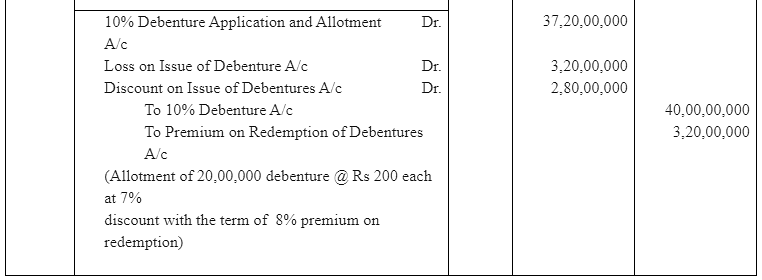
Question 9: M.Ltd. took over assets of Rs 9,00,00,000 and liabilities of Rs 70,00,000 of S.Ltd. and issued 8% benture of Rs 100 each. Record necessary entries in the books of M. Ltd.
ANSWER: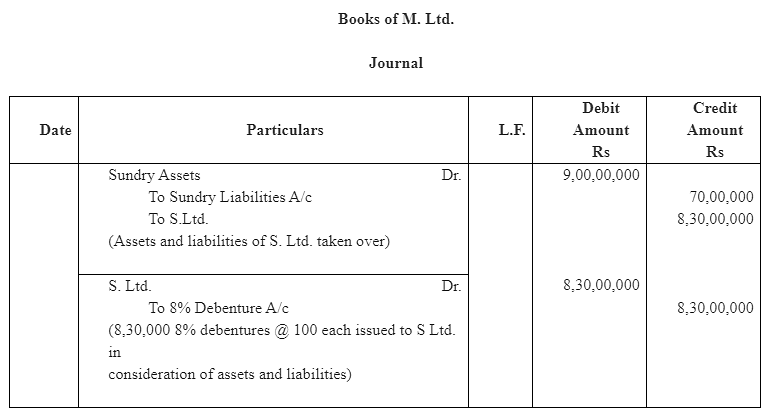
Question 10: B.Ltd. purchased assets of the book value of Rs 4,00,000 and took over the liability of Rs 50,000 from Mohan Bros. It was agreed that the purchase consideration, settled at Rs,3,80,000, be paid by issuing debentures of Rs 100 each.
What Journal entries will be made in the following three cases, if debentures are issued: (a) at par; (b) at discount; (c) at premium of 10%? It was agreed that any fraction of debentures be paid in cash.
ANSWER:
Case (a)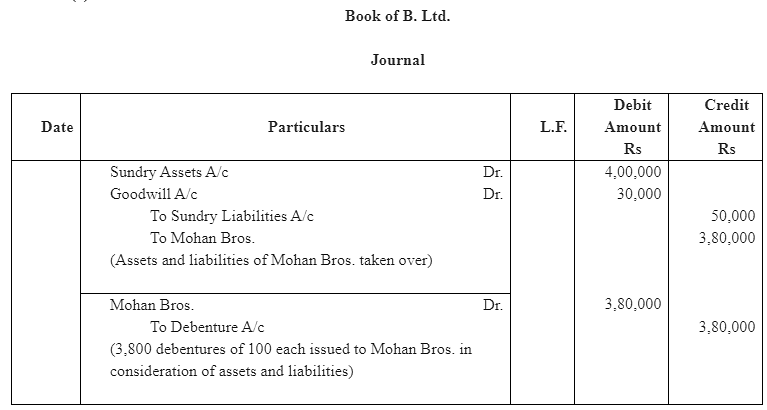
Case (b) 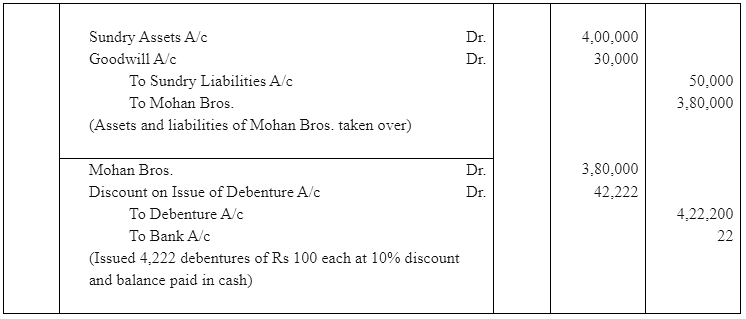
Case (c)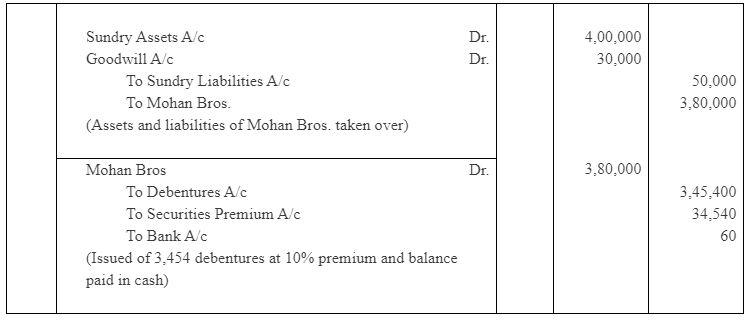
Page No 145:
Question 11: X.Ltd. purchased a Machinery from Y for an agreed purchase consideration of Rs 4,40,000 to be satisfied by the issue of 12% debentures of Rs 100 each at a premium of Rs 10 per debenture. Journalise the transactions.
ANSWER: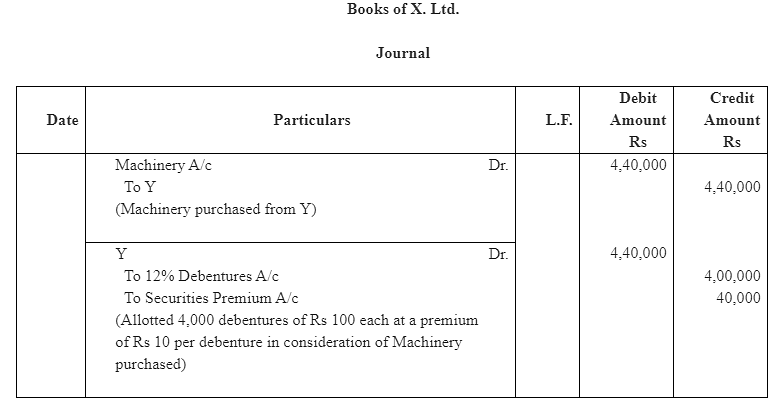
Question 12: X.Ltd. issued 15,000, 10% debentures of Rs 100 each. Give journal entries and the Balance Sheet in each of the following cases:
(i) The debentures are issued at a premium of 10%;
(ii) The debentures are issued at a discount of 5%;
(iii) The debentures are issued as a collateral security to bank against a loan of Rs 12,00,000; and
(iv) The debentures are issued to a supplier of machinery costing Rs 13,50,000.
ANSWER: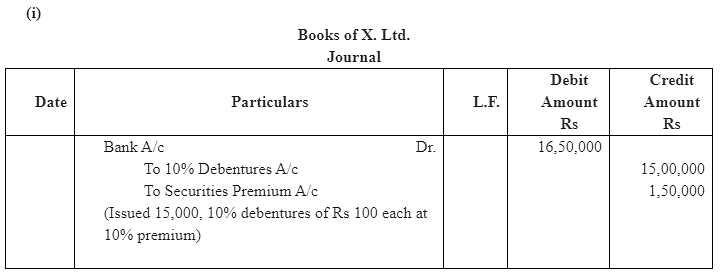
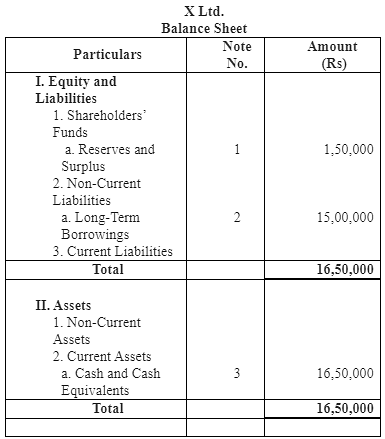
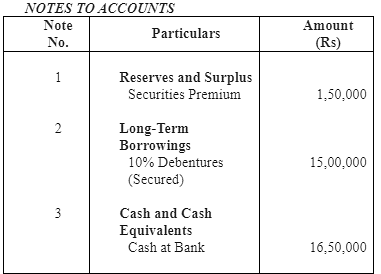

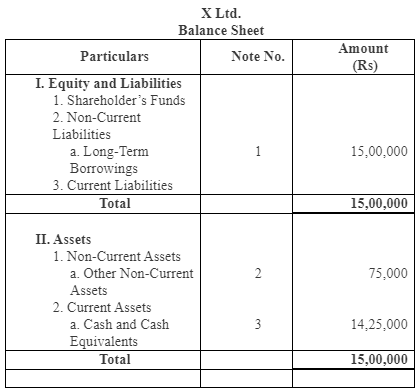
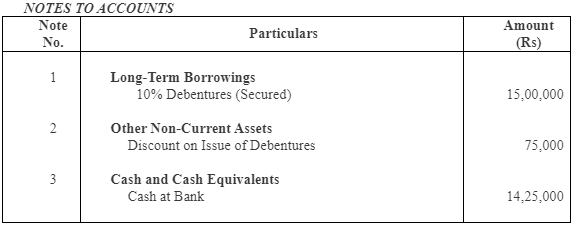
(iii) No entry will be passed for issuing debentures as a collateral security


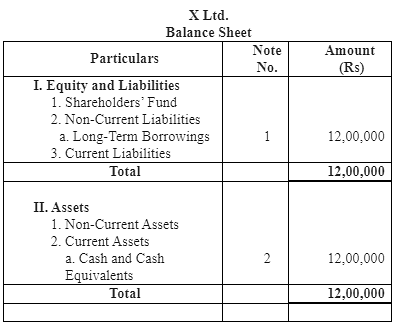

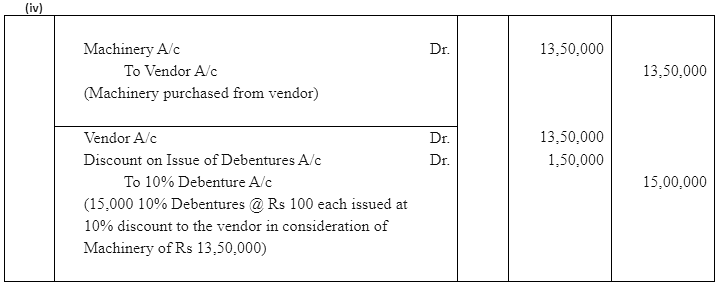
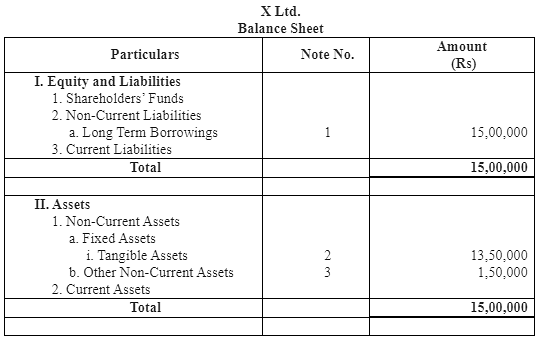

Question 13: Journalise the following:
(i) A debenture issued at Rs 95, repayable at Rs 100;
(ii) A debenture issued at Rs 95, repayable at Rs 105; and
(iii) A debenture issued at Rs 100, repayable at Rs 105;
The face value of debenture in each of the above cases is Rs 100.
ANSWER: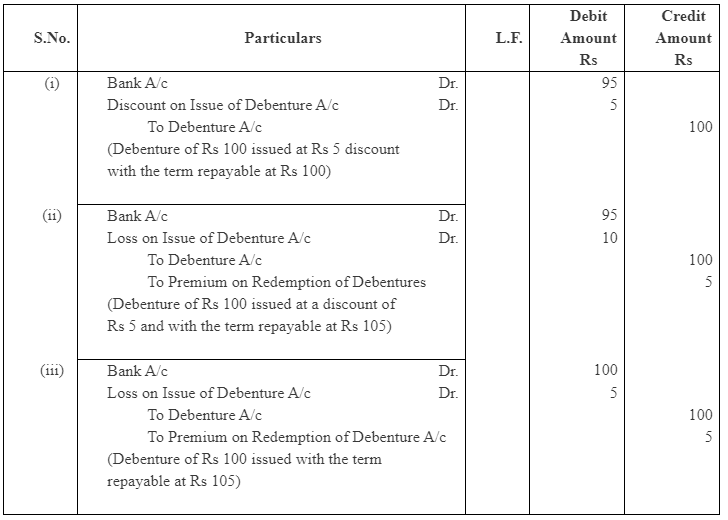
Question 14: A.Ltd. issued 50,00,000, 8% Debenture of Rs 100 at a discount of 6% on April 01, 2009 redeemable at premium of 4% by draw of lots as under:
20,00,000 Debentures on March, 2011
10,00,000 Debentures on March, 2013
20,00,000 Debentures on March, 2014
Compute the amount of discount to be written-off in each year till debentures are paid. Also prepare discount/loss on issue of debenture account.
ANSWER:
Loss on issue of debenture = 6% (discount on issue) + 4% (premium on redemption) = 10%
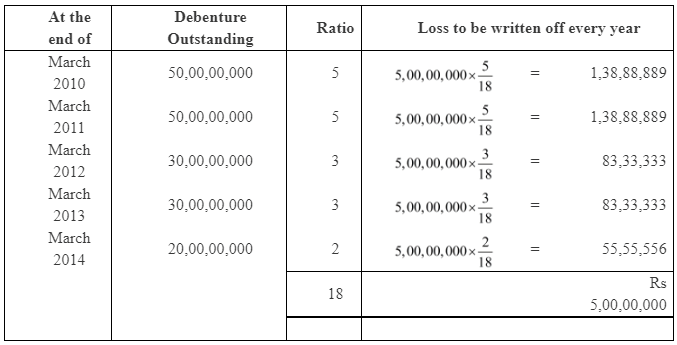
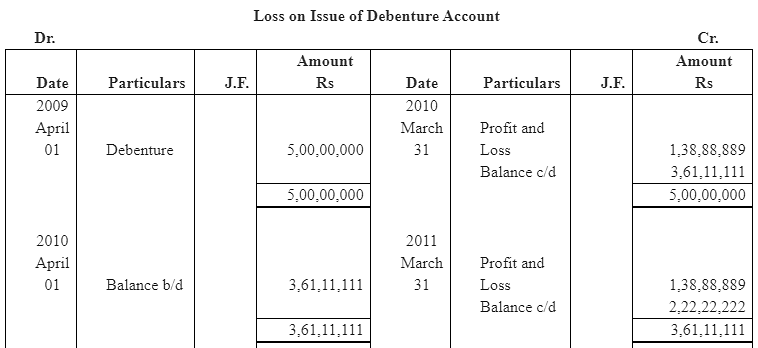
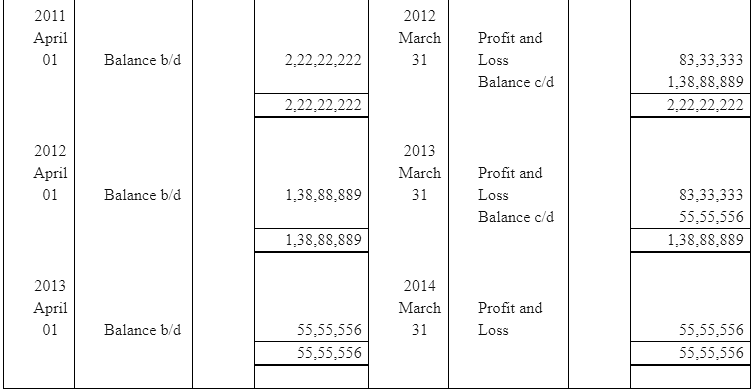
Question 15: A company issues the following debentures:
(i) 10,000, 12% debentures of Rs 100 each at par but redeemable at premium of 5% after 5 years;
(ii) 10,000, 12% debentures of Rs 100 each at a discount of 10% but redeemable at par after 5 years;
(iii) 5,000, 12% debentures of Rs 1,000 each at a premium of 5% but redeemable at par after 5 years;
(iv) 1,000, 12% debentures of Rs 100 each issued to a supplier of machinery costing Rs 95,000. The debentures are repayable after 5 years; and
(v) 300, 12% debentures of Rs 100 each as a collateral security to a bank which has advanced a loan of Rs 25,000 to the company for a period of 5 years.
Pass the journal entries to record the: (a) issue of debentures; and (b) repayment of debentures after the given period.
ANSWER: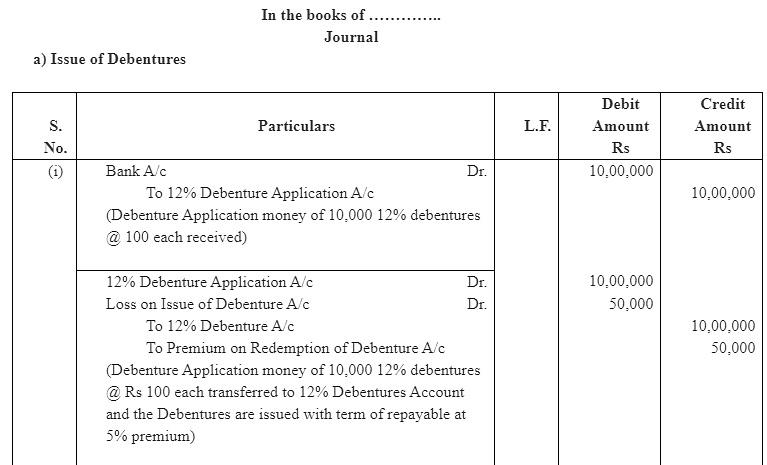

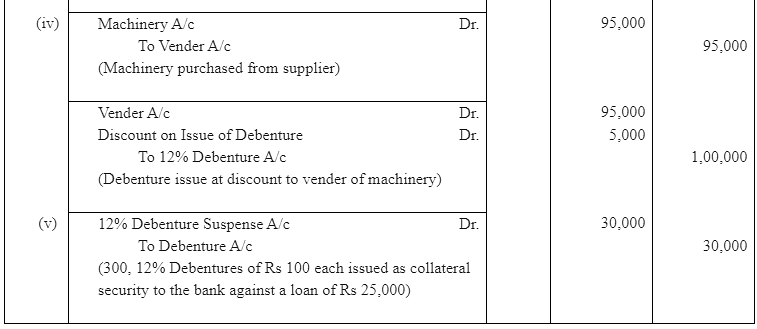
b) Repayment of Debentures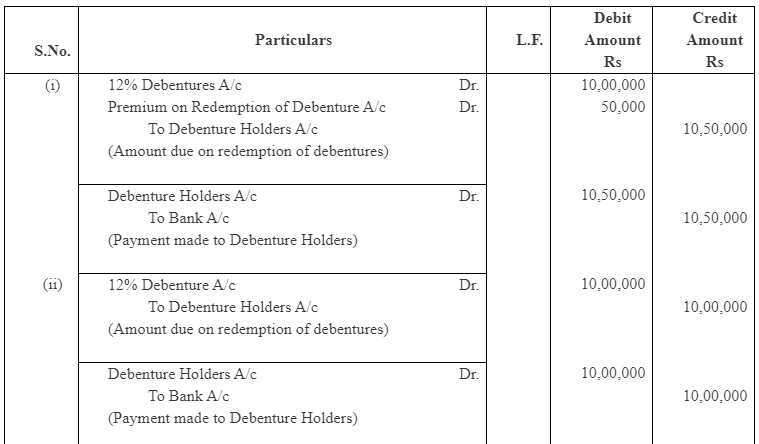
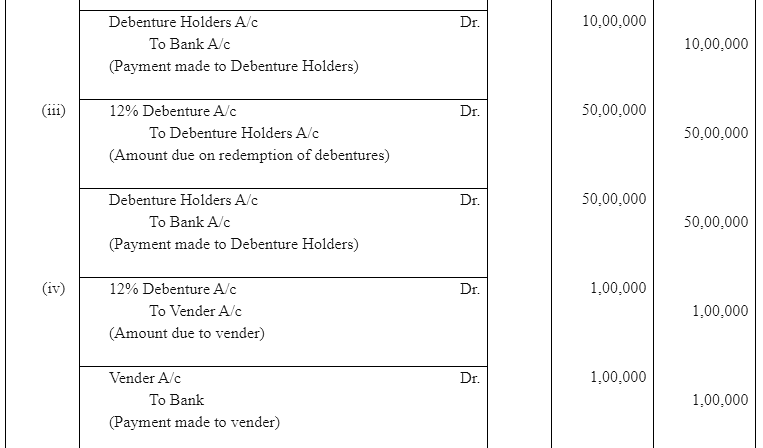

Question 16: A company issued debentures of the face value of Rs 5,00,000 at a discount of 6% on April 01, 2012. These debentures are redeemable by annual drawings of Rs. 1,00,000 made on March 31 each year. The directors decided to write off discount based on the debentures outstanding each year.
Calculate the amount of discount to be written-off each year. Give journal entries also.
ANSWER: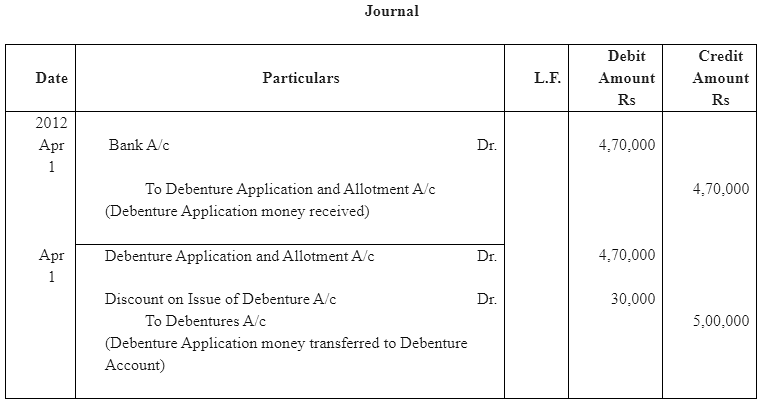
Amount of Discount on issue of Debenture = 
Assuming that the amount of discount on issue of debentures is to be written off in 5 years.
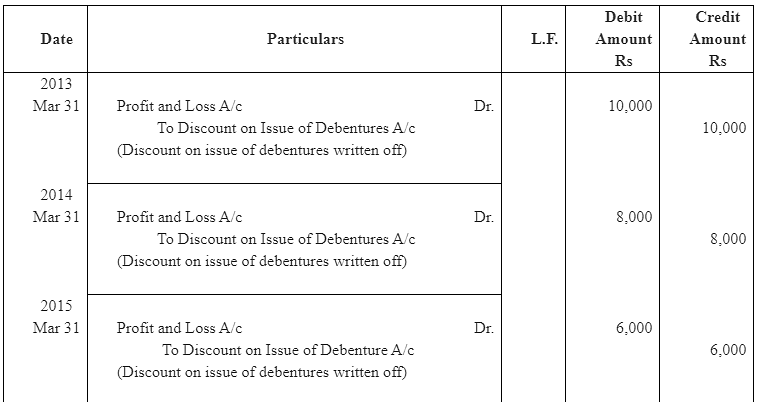

Page No 146:
Question 17:
A company issued 10% Debentures of the face value of Rs,1,20,000 at a discount of 6% on April 01, 2011. The debentures are payable by annual drawings of Rs 40,000 commencing from the end of third year.
How will you deal with discount on debentures?
Show the discount on debentures account in the company ledger for the period of duration of debentures. Assume accounts are closed on March 31 every year.
ANSWER:
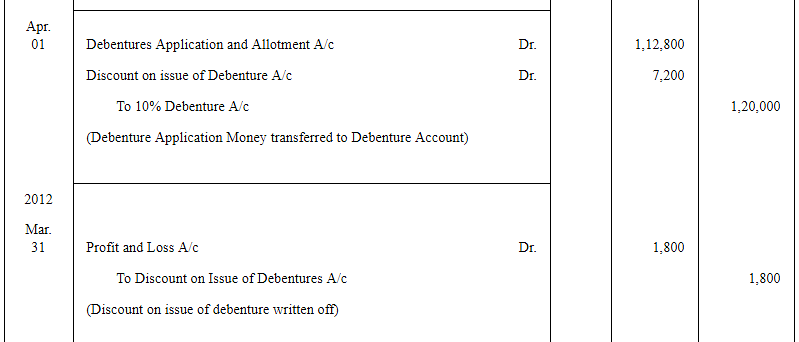
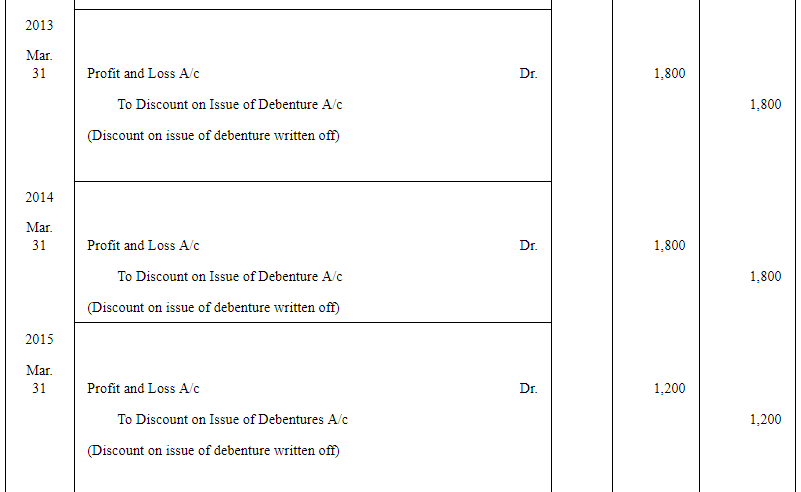

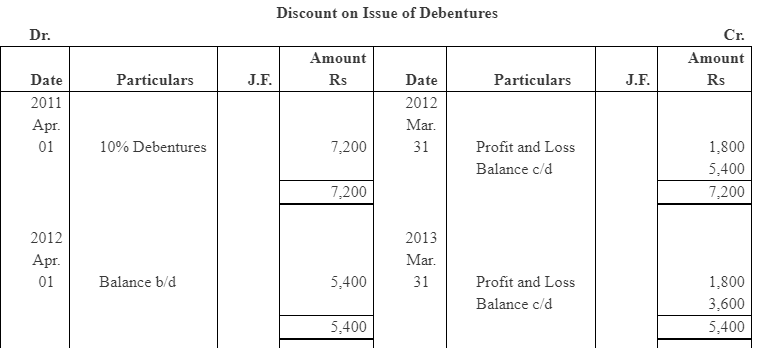

i) Working Note:
Amount of Discount on Issue of Debenture 
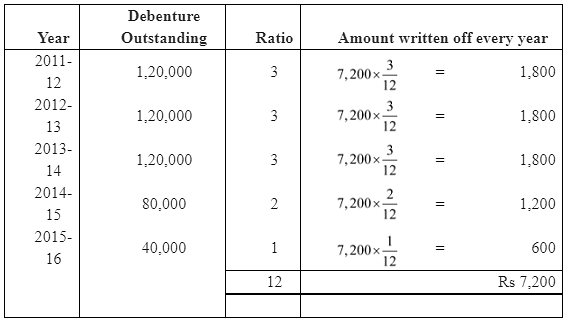
Question 18: B.Ltd. issued debentures at 94% for Rs 4,00,000 on April 01, 2011 repayable by five equal drawings of Rs 80,000 each. The company prepares its final accounts on March 31* every year.
Indicate the amount of discount to be written-off every accounting year assuming that the company decides to write off the debentures discount during the life of debentures. (Amount to be written-off: 2011 Rs 6,000; 2012 Rs 6,800; 2013 Rs 5,200; 2014 Rs 3,600; 2015 Rs 2,000; 2016 Rs 400).
*It should be December 31
ANSWER: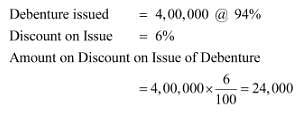
Amount of discount to written off every year
In 2011 = Rs 6,000
In 2012 = 2,000 + 4,800 = Rs 6,800
In 2013 = 1,600 + 3,600 = Rs 5,200
In 2014 = 1,200 + 2,400 = Rs 3,600
In 2015 = 800 + 1,200 = Rs 2,000
In 2016 = Rs 400
Working Notes
i) Amount of discount to be written off every year

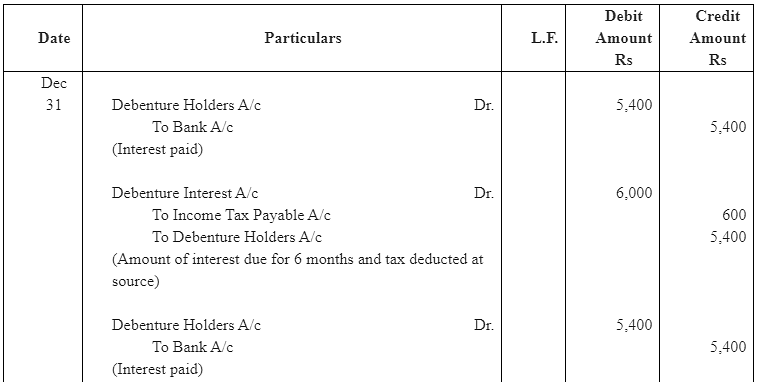

Note: In the question, the closing date of the accounting year is March 31, however, it should be December 31.
Question 19: B. Ltd. issued 1,000, 12% debentures of Rs 100 each on April 01, 2014 at a discount of 5% redeemable at a premium of 10%.
Give journal entries relating to the issue of debentures and debentures interest for the period ending March 31, 2015 assuming that interest is paid half yearly on September 30 and March 31 and tax deducted at source is 10%.
Answer :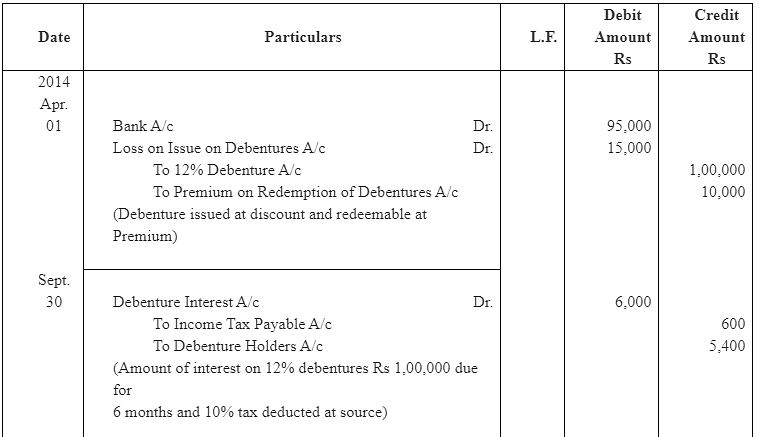


Question 20: What journal entries will be made in the following cases when company redeems debentures at the expiry of period by serving the notice: (a) when debentures were issued at par with a condition to redeem them at premium; (b) when debentures were issued at premium with a condition to redeem that at par; and (c) when debentures were issued at discount with a condition to redeem them at premium?
Answer 20: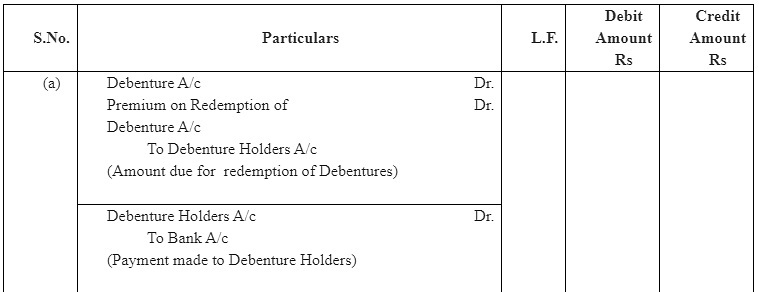

Question 21: On January 01, 2012, X. Ltd. issues 5,000, 8% Debentures of Rs 100 each repayable at par at the end of three years. It has been decided to set up a cumulative sinking fund for the purpose of their redemption. The investments are expected to realise 4% net. The Sinking Fund Table shows that Rs 0.320348 amounts to one rupee @4% per annum in three years. On December 31, 2015 the balance at bank was Rs 2,42,360 and the investments realised Rs 3,25,000. The debentures were paid off.
Give journal entries and show ledger account.
Answer 21:
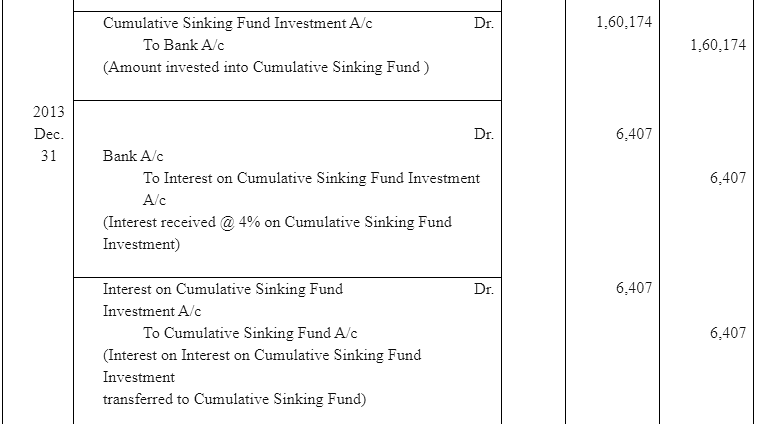
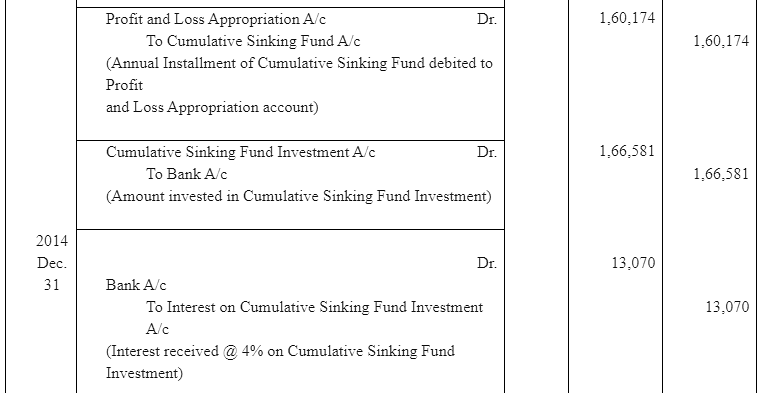

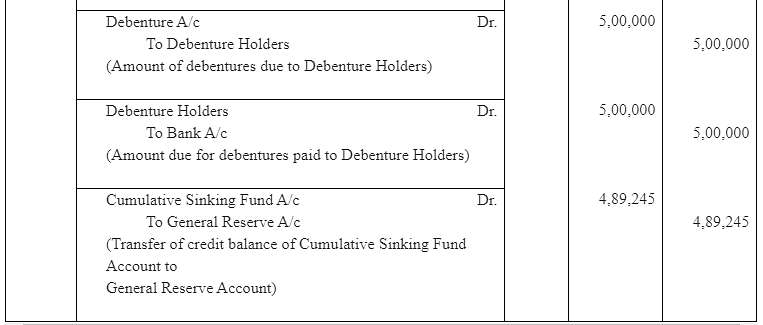
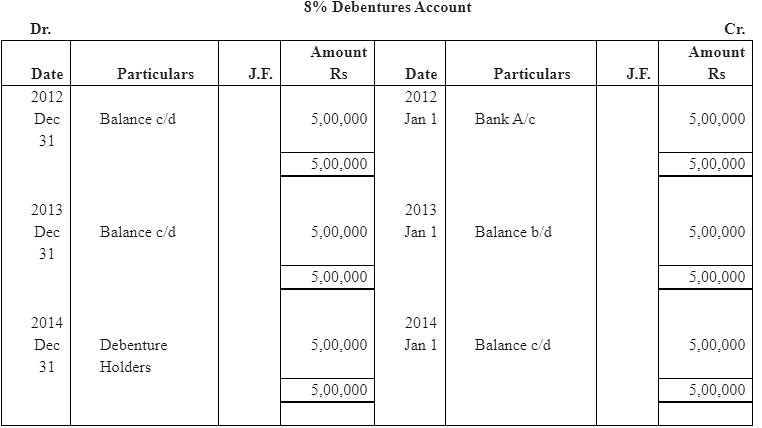
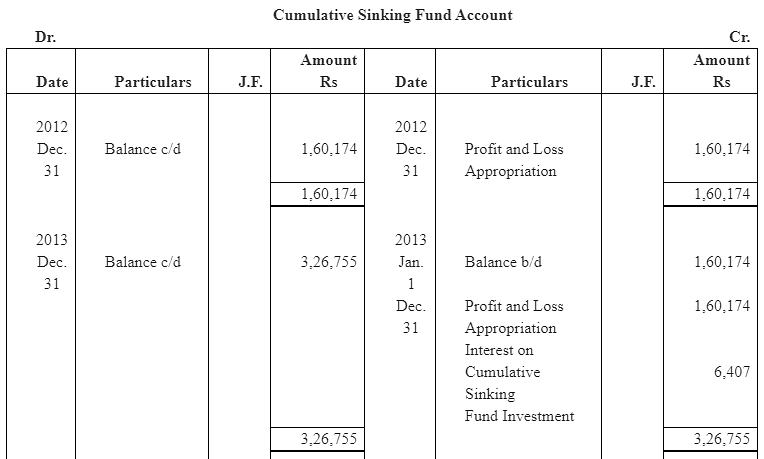
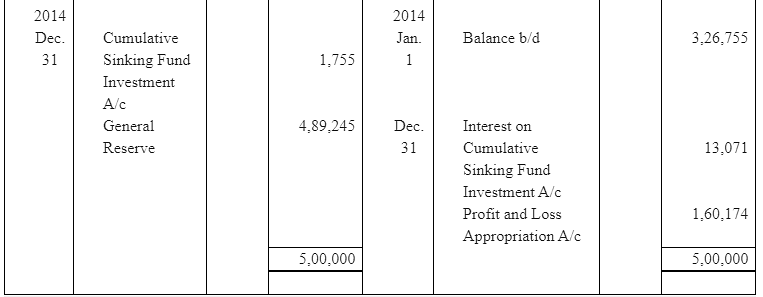

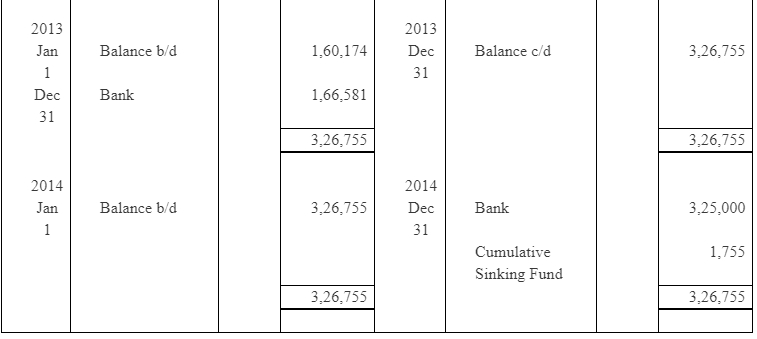
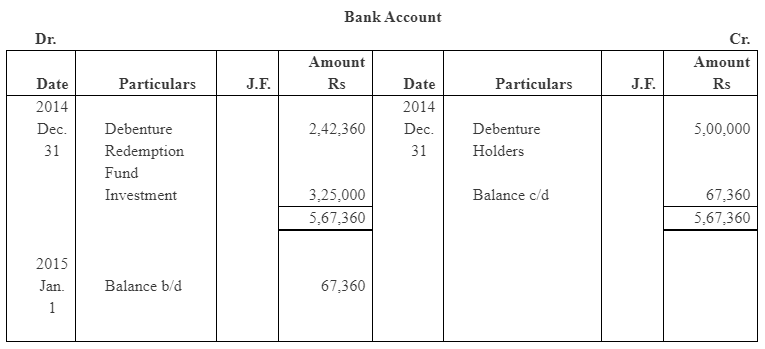
Question 22: On April 01, 2014 a company issued 15% debentures of Rs 10,00,000 at par. The debentures were redeemable at par after three years from the date of Issue. A sinking fund was set up to raise funds for redemption of debentures. The amount for the purpose was invested in 6% Government securities of Rs 100 each available at par. The sinking fund table shows that if investments earn 6% per annum, to get Re.1 at the end of 3 years, one has to invest Rs 0.31411 every year together with interest that will be earned. On March 31, 2017, all the Government securities were sold at a total loss of Rs 6,000 and the debentures were redeemed at par.
Prepare Debentures Account Sinking Fund Account, Sinking Fund Investment Account and Interest on Sinking Fund Investment Company closes its books of accounts every year on March 31.
Answer :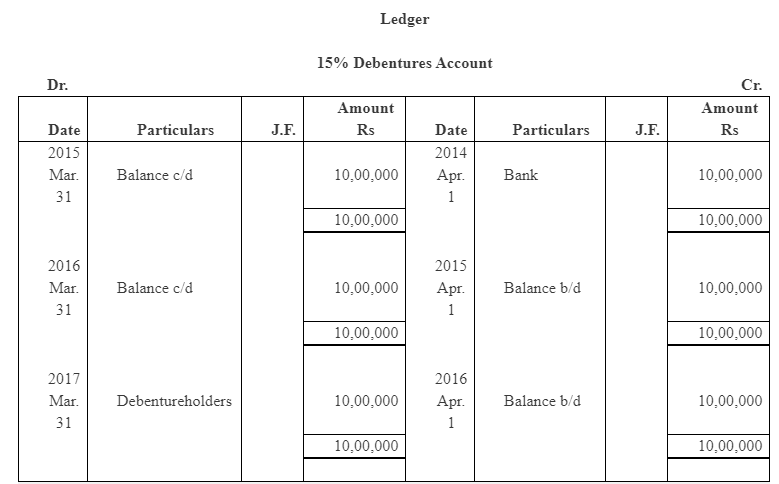
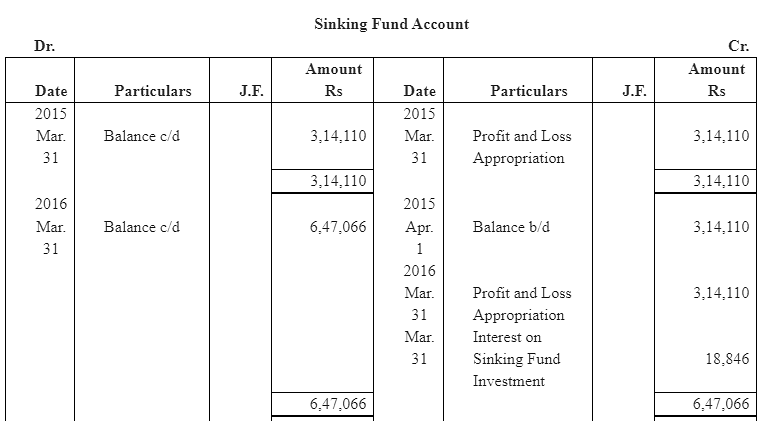


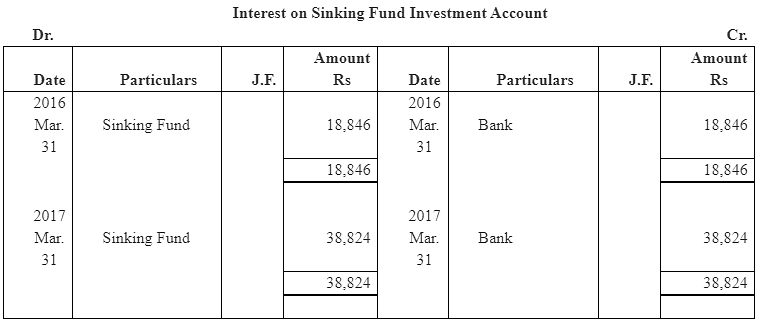
Question 23: On April 01, 2016 the following balances appeared in the books of Z. Ltd.:
The investments consisted of 4% Government securities of the face value of Rs 90,000.
The annual instalment was Rs 16,400. On March 31, 2017, the balance at Bank was Rs 26,000 (after receipt of interest on D.R.Reserve Fund Investment). Investments were realised at 92% and the Debentures were redeemed. The interest for the year had already been paid.
Show the ledger accounts affecting redemption.
Answer :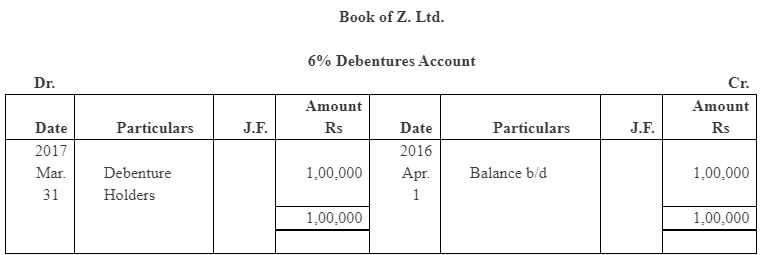
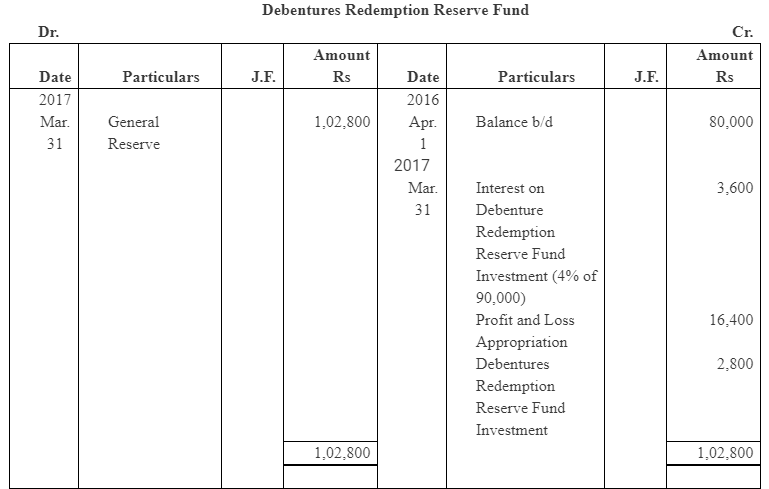
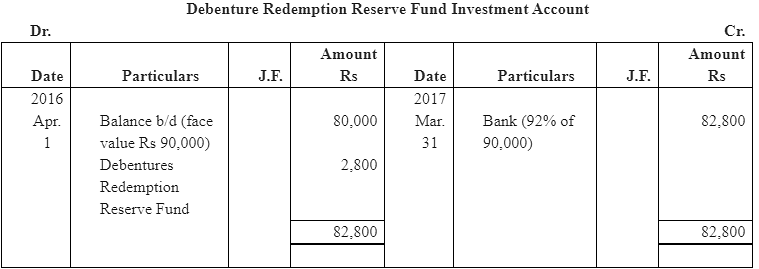
Question 24: The following balances appeared in the books of A.Ltd. on April 01, 2017
On April 01, 2017, the company redeemed all the debentures at 105 per cent out of funds raised by selling all the investments at Rs 3,48,000. Prepare the necessary ledger accounts.
Answer: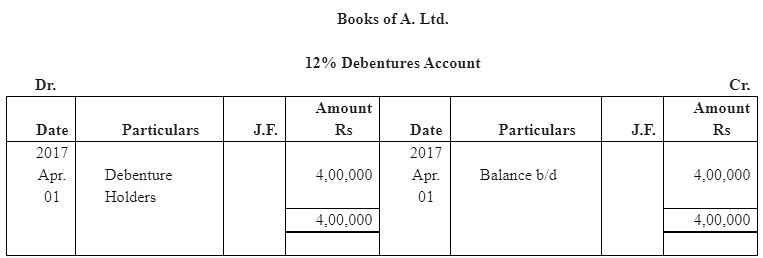
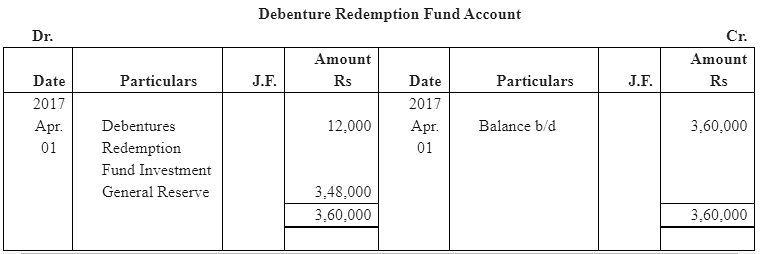

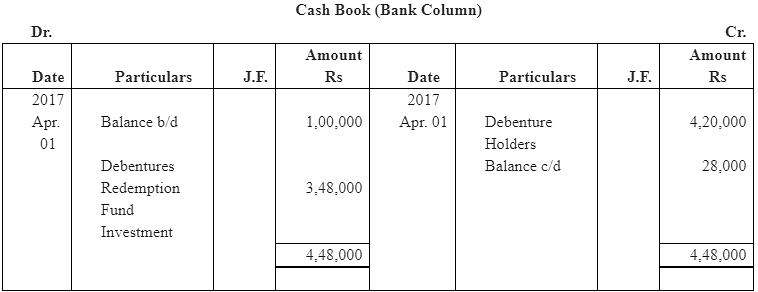

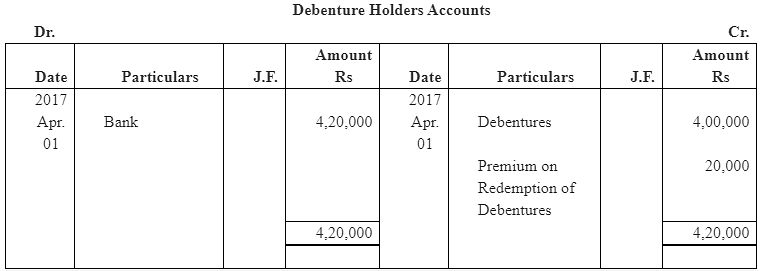
Question 25: The following balances appeared in the books of Z.Ltd. on April 01, 2016
The annual instalment added to the fund is Rs 20,575. On March 31, 2017, the bank balance after the receipt of interest on the investment was Rs 39,100. On that date, all the investments were sold at 83 per cent and the debentures were duly redeemed.
Show the necessary ledger accounts for the year 2016-17.
Answer :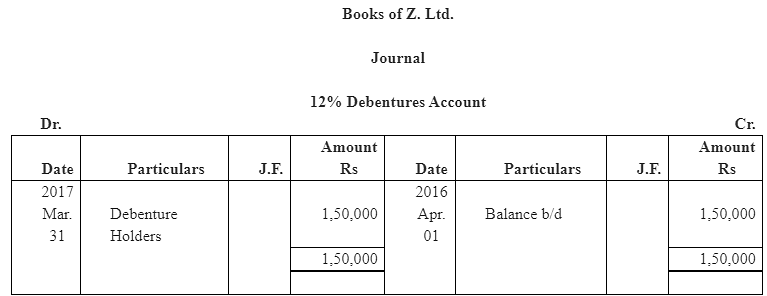
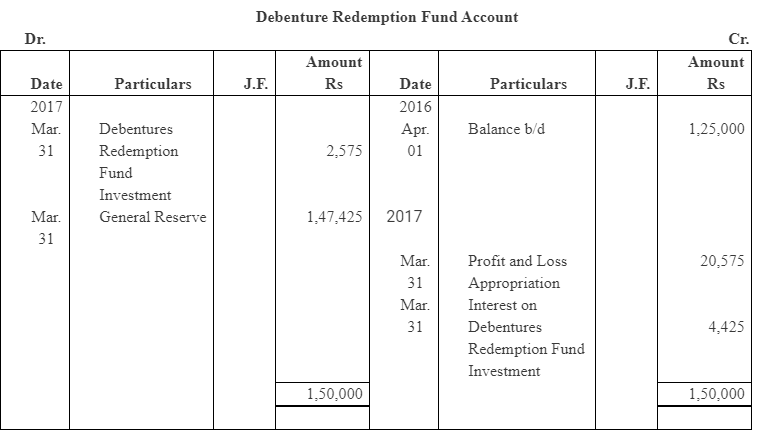
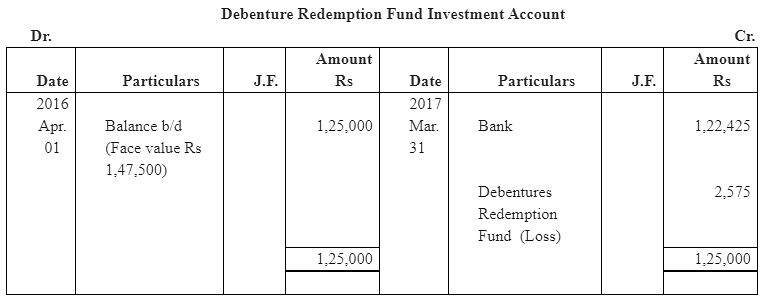
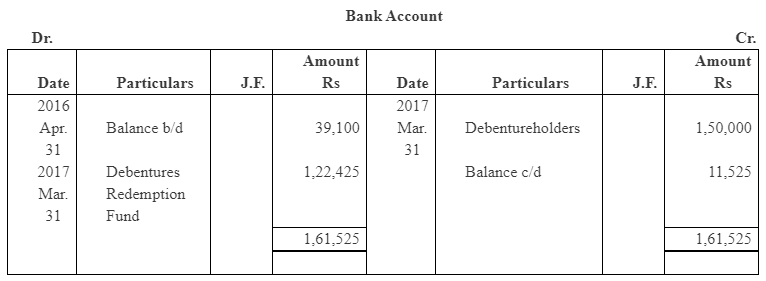
Question 26: What entries for the redemption of debentures will be done when : (a) debentures are redeemed by annual drawings out of profits; (b) debentures are redeemed by drawing a lot out of capital; and (c) debentures are redeemed by purchasing them in the open market when sinking fund for the redemption of debentures is not maintained − (i) when out of profit, and (ii) when out of capital?
Answer :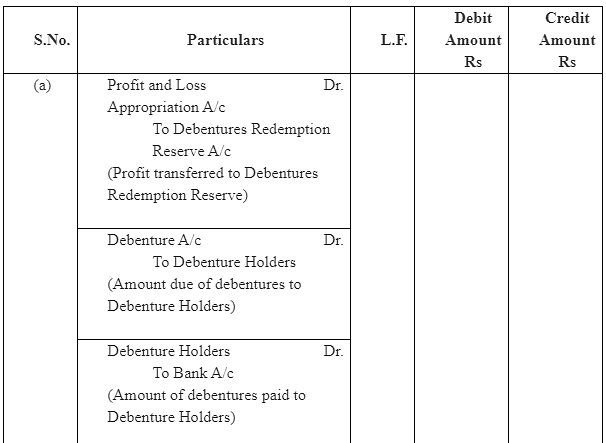

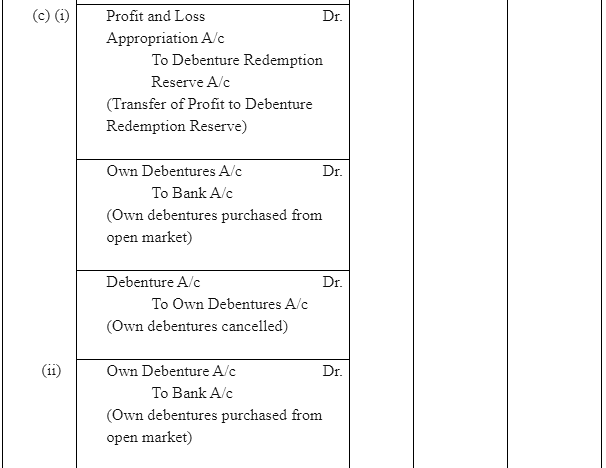

Question 27: A. Ltd. Company issued Rs,5,00,000 Debentures at a discount of 5% repayable at par by annual drawings of Rs.1,00,000.
Make the necessary ledger accounts in the books of the company for the first year.
Answer: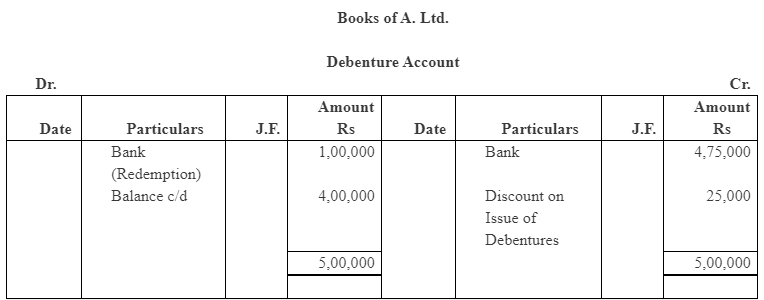

Discount on issue of Debenture = 
Writing of Discount on Issue of Debenture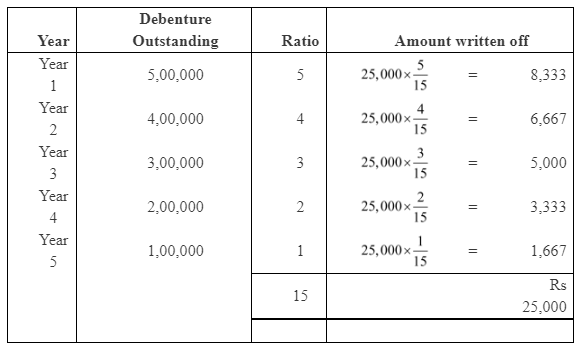
Question 28: X.Ltd. issued 5,000, 15% debentures of Rs.100 each on April 01, 2013 at a discount of 10%, redeemable at a premium of 10% in equal annual drawings in 4 years out of capital.
Give journal entries both at the time of issue and redemption of debentures. (Ignore the treatment of loss on issue of debentures and interest.)
Answer 28:
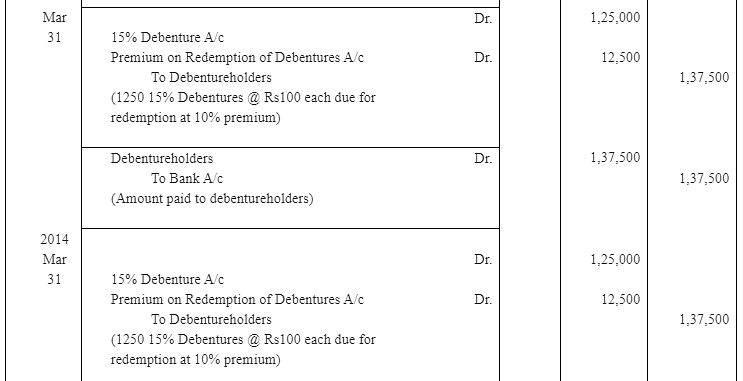
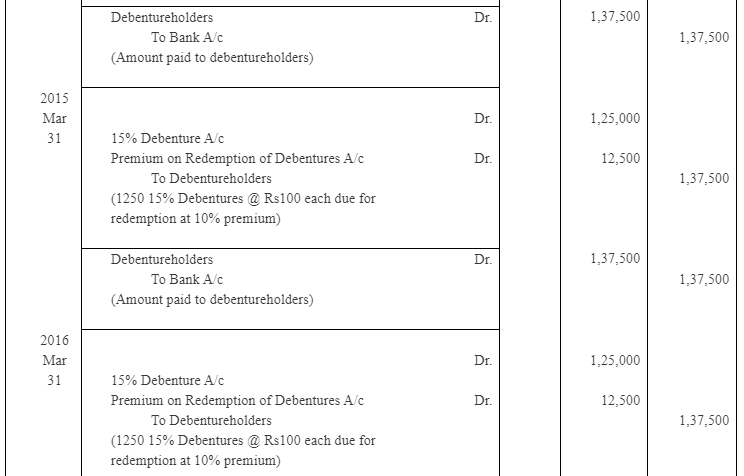

Question 29: Z.Ltd. issued 2,000, 14% debentures of Rs.100 each on April 01, 2013 at a discount of 10%, redeemable at a premium of 10% in equal annual drawings in 4 years out of profits.
Give journal entries both at the time of issue and redemption of debentures. (Ignore the treatment of loss on issue of debentures and interest.)
Answer :
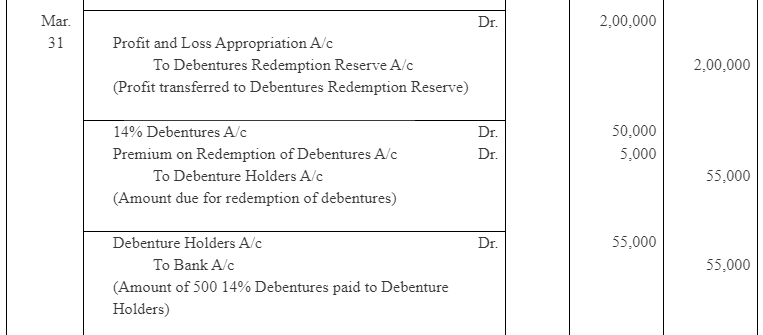

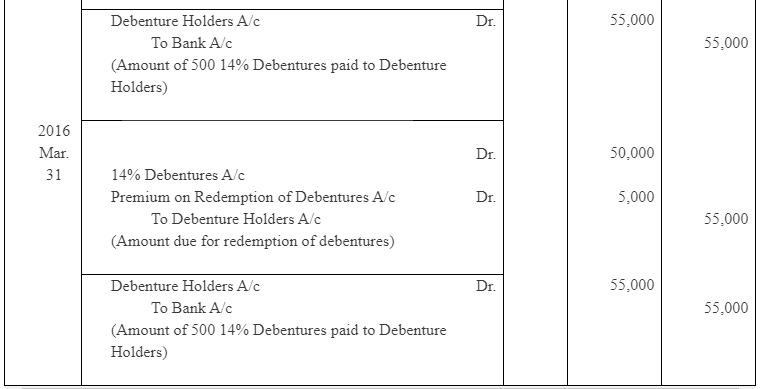
Question 30: A.Ltd. purchased its own debentures of the face value of Rs.2,00,000 from the open market for immediate cancellation at Rs.92. Record the journal entries.
Answer: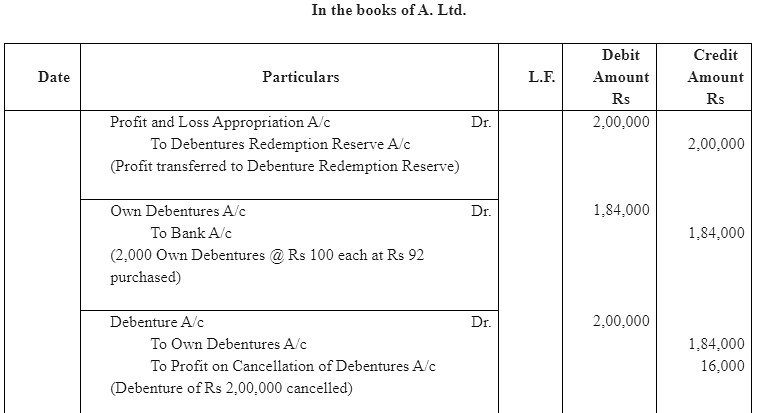

Question 31: X.Ltd. redeemed 1,000, 12% debentures of Rs.50 each by converting them into 15% New Debentures of Rs.100 each. Journalise.
Answer : 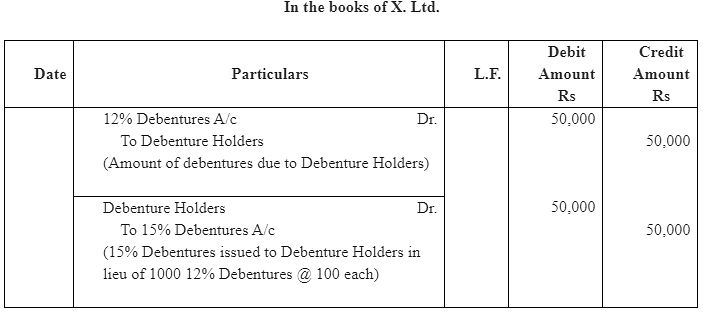
Working Notes:-
Number of Debentures to be issued
Question 32: On April 01, 2014, a company made an issue of 5,000, 8% debentures of Rs 100 each at Rs 94 per debentures. The terms of issue provided for the redemption of 1,000 debenture every year starting from March 31, 2016 either by purchase from open market or by converting them into Equity shares of Rs 10 each at a premium of Rs 2.50 per share. On March 31, 2016, the company redeemed 1,000 debentures by converting them into equity shares. Give the necessary journal entries.
Answer :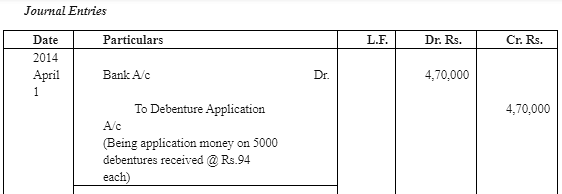
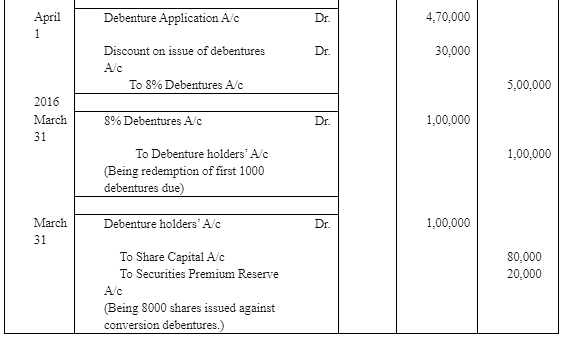

|
47 videos|180 docs|56 tests
|
FAQs on NCERT Solution (Part - 2) - Issue and Redemption of Debentures - Accountancy Class 12 - Commerce
| 1. What is the meaning of debentures? |  |
| 2. What is the process of issuing debentures? |  |
| 3. What is the difference between issue price and face value of debentures? |  |
| 4. How are debentures redeemed? |  |
| 5. What are the advantages of issuing debentures for a company? |  |

|
Explore Courses for Commerce exam
|

|


















